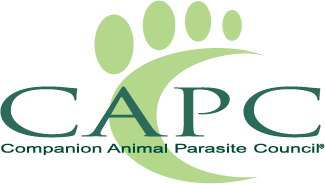Companion Animal Parasite Council 2025 Pet Parasite Forecast Warns Parasitic Diseases Affecting Pets and People Continue to Spread
Based on 10M Diagnostic Tests Reported Each Year, Forecasts Highlight Expanding Risk of Lyme, Heartworm, Anaplasmosis and Ehrlichiosis with 94% Accuracy
Pet owners and veterinarians can also assess local parasite disease threats for free at www.petdiseasealerts.org, CAPC’s monthly pet parasite forecast maps
SALEM, ORE. (April 14, 2025) — The nonprofit Companion Animal Parasite Council (CAPC) – the leading authority on vector-borne diseases affecting pets and people – warns in its just-released 2025 Pet Parasite Forecast that Lyme, heartworm, anaplasmosis and ehrlichiosis diseases continue to spread throughout the United States. Based on more than 10 million diagnostic tests reported each year, CAPC’s annual forecasts help veterinarians and pet parents assess disease risk in their neighborhoods.
CAPC has been precisely forecasting parasitic diseases since 2012 with 94% accuracy in predicting the true prevalence of four diseases – Lyme, heartworm, anaplasmosis and ehrlichiosis – across the United States.
“The CAPC maps are an invaluable resource for veterinarians and pet owners,” said CAPC Board President Dr. Brian Herrin. “These forecasts provide critical insights for both pet and public health, as pets and their owners live and play in the same places. It’s also important to remember that low risk doesn’t mean no risk, so year-round prevention is essential to keeping pets safe from these potentially fatal diseases.”
In its 2025 Pet Parasite Forecast, CAPC highlights the continued geographic expansion of pet and human vector-borne diseases, primarily due to shifting tick and mosquito populations:
- Specifically, tick-borne diseases Lyme and anaplasmosis continue to expand south and west in the United States with the upper Midwest and northeast continuing to be high risk areas. Ehrlichiosis, also spread by ticks, remains high throughout the southeast, with continued northward expansion in the upper Midwest and the New England region.
- Meanwhile, mosquitoes are increasingly spreading heartworm disease in the southeastern United States, where the highest risks are found along the Atlantic coast and northward along the Mississippi river. This puts much of the middle of the United States, from Kansas to Maryland, at a heightened risk for heartworm infection. In addition, there are growing areas of increased risk in New Mexico, Colorado, Wyoming, Montana, North Dakota and Northern California.
The increasing threats in both endemic and emerging regions underscore the importance of administering preventatives to pets year-round. Dogs serve as sentinels for human health, as areas with high canine infection rates often indicate increased risk for people. Veterinarians are urged to reinforce the prevention of tick and mosquito exposure, assess individual pet risk based on lifestyle and travel, and utilize vaccination and testing to help mitigate the spread of these diseases.
“CAPC’s annual forecasts for Lyme, heartworm, anaplasmosis and ehrlichiosis should serve as a call to action for veterinarians and pet owners,” said Dr. Rick Marrinson, Board member/past president for CAPC and practitioner in Longwood, Florida. “In historically endemic regions, these maps reinforce the importance of continued vigilance in testing and prevention. Meanwhile, in areas where these diseases are emerging, veterinarians should adapt new protocols to address the real and growing threats facing pets and people in their communities.”
In addition to informing veterinary practices, the forecasts also underscore the broader public health implications of vector-borne diseases. A CAPC study confirmed that dogs serve as sentinels for human health, helping to identify where people face the greatest risk of tick-borne Lyme disease.
“Because dog health helps us predict human health, our monthly, county-by-county forecasts are a crucial health tool for communities,” said CAPC CEO Dr. Christopher Carpenter, DVM, MBA. “Each year, we see a growing need for education and preventive care to curb the spread of these diseases. By leveraging the power of our extensive canine surveillance data, we help veterinarians and pet owners take proactive steps to safeguard animal and human health. We hope our forecasts spark meaningful conversations about how we can collectively lower disease risk.”
Free, 30-Day Pet Parasite Forecasts
In addition to its annual forecast, CAPC provides 30-Day Pet Parasite Forecasts at www.PetDiseaseAlerts.org, which allow veterinarians and pet owners to track emerging threats locally. These local forecasts by county, paired with annual forecasts, remind pet owners of the continuous risk in their area, and reinforce the importance of year-round parasite prevention and routine testing to protect both pets and their families.
CAPC daily Flea Forecasts also are available at www.PetDiseaseAlerts.org. They display flea activity across the United States based on environmental conditions. These forecasts assist pet owners and veterinarians in understanding and mitigating flea-related challenges.
How CAPC Forecasts are Created
Parasitologists and statisticians in leading academic institutions across the United States who conduct ongoing research and data interpretation collaborate to develop the annual CAPC Pet Parasite Forecasts. Their goal is to better understand and monitor vector-borne disease agent transmission, as well as changing life cycles of parasites.
The science behind CAPC’s Forecasts involves a comprehensive analysis of multiple factors, including temperature, precipitation and population density. This robust methodology ensures the Forecasts are strongly rooted in evidence, making them powerful tools for predicting where dogs are testing positive for Lyme, ehrlichiosis, anaplasmosis and heartworm diseases. More than 12 peer-reviewed articles about these forecasts have demonstrated that CAPC Forecasts are highly accurate.
About the Companion Animal Parasite Council
The Companion Animal Parasite Council (www.capcvet.org) is an independent not-for-profit organization comprised of parasitologists, veterinarians, as well as medical, public health and other professionals, who provide information for the optimal control of internal and external parasites that threaten the health of pets and people. Formed in 2002, CAPC works to help veterinary professionals and pet owners develop the best practices in parasite management that protect pets from parasitic infections and reduce the risk of zoonotic disease transmission.
###
